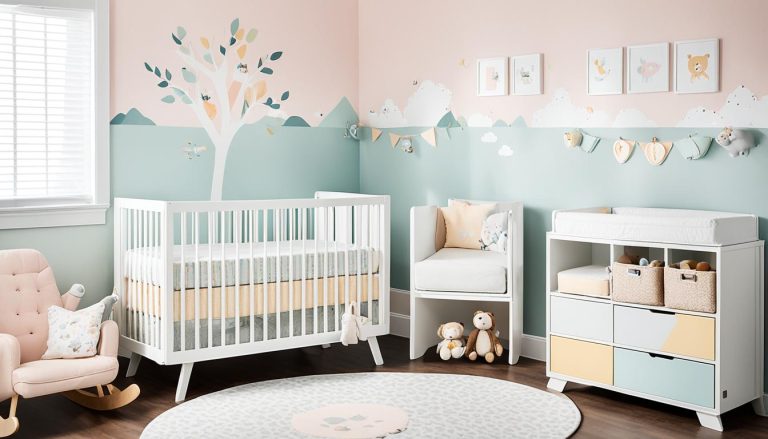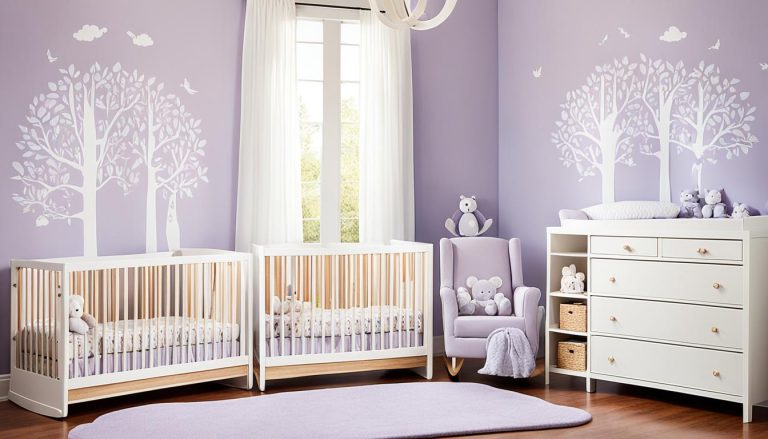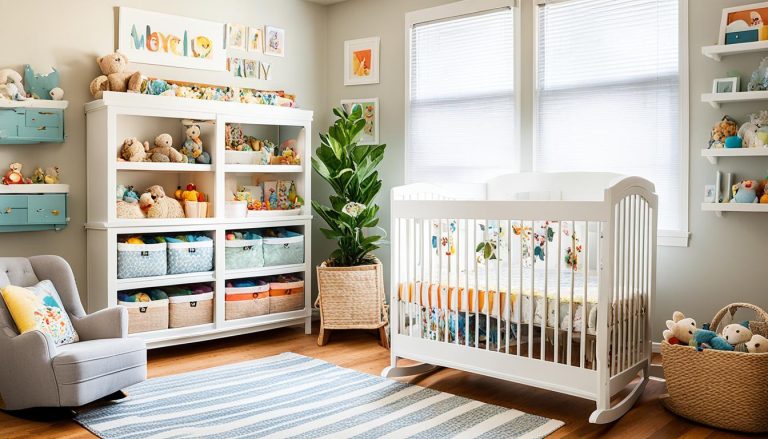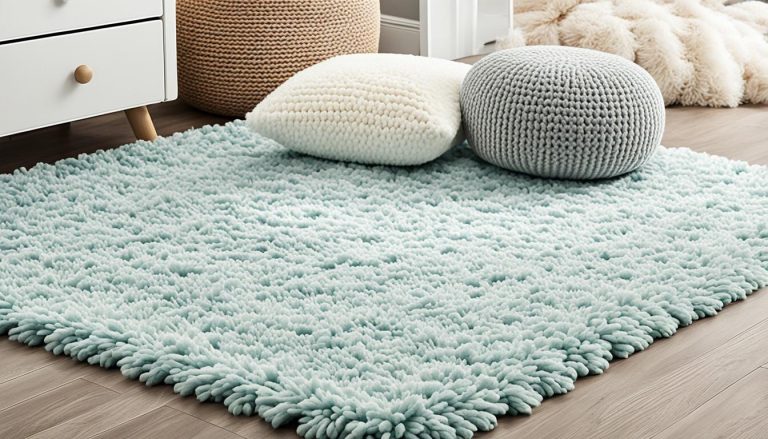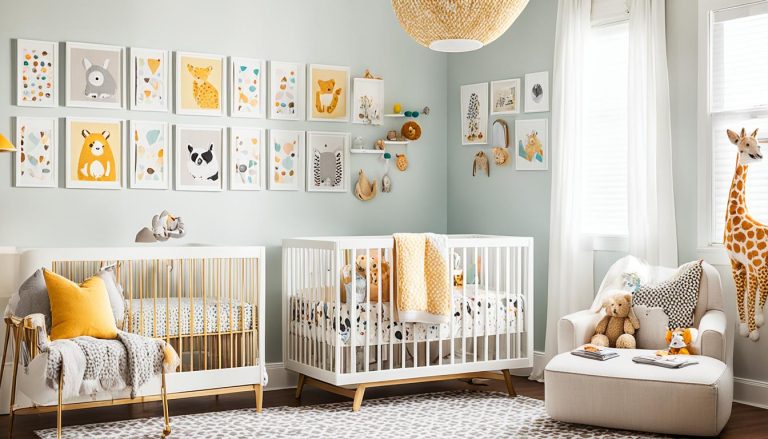Choosing the Right Crib for Your Nursery | Baby Tips
houseremodelingnews.com may earn a commission if you purchase a product through one of our links
Is your baby’s sleep safety keeping you up at night? As you prepare for your little one’s arrival, picking the perfect crib is key. It’s not just about finding something cute for your nursery. It’s about making a safe place for your baby to sleep.
Cribs are crucial for baby safety, as newborns spend up to 16 hours a day sleeping. That’s why choosing a crib that meets strict safety standards is vital. It should also match your nursery’s look.
Did you know the most popular crib size fits mattresses that are 52″ x 28″? Also, convertible cribs can last from infancy to around age 5. These cribs offer great value but might cost more.
When looking for a crib, check for adjustable mattress heights, teething rails, and wheels with locks. These features add to both safety and ease. Make sure the crib slats are no more than 2 3/8 inches apart to prevent accidents.
Are you ready to learn more about cribs? Let’s look at the different types, materials, and essential safety features. This will help make sure your baby’s sleep is as safe as possible.
Understanding Crib Safety Standards
Setting up your baby’s nursery means putting safety first. The Consumer Product Safety Commission (CPSC) has strict crib standards. These rules cover slat spacing and mattress support durability.
CPSC Regulations
Since 2011, CPSC has set rules for cribs. Cribs must have:
- Slats no more than 2 ⅜ inches apart
- Sturdy mattress supports
- Durable hardware
- No drop-sides
These rules help prevent accidents and keep your baby safe.
JPMA Certification
Check for JPMA certified cribs. The Juvenile Products Manufacturers Association (JPMA) certification is more than basic safety. It means the crib has passed tough tests, giving you confidence in your baby’s sleep space.
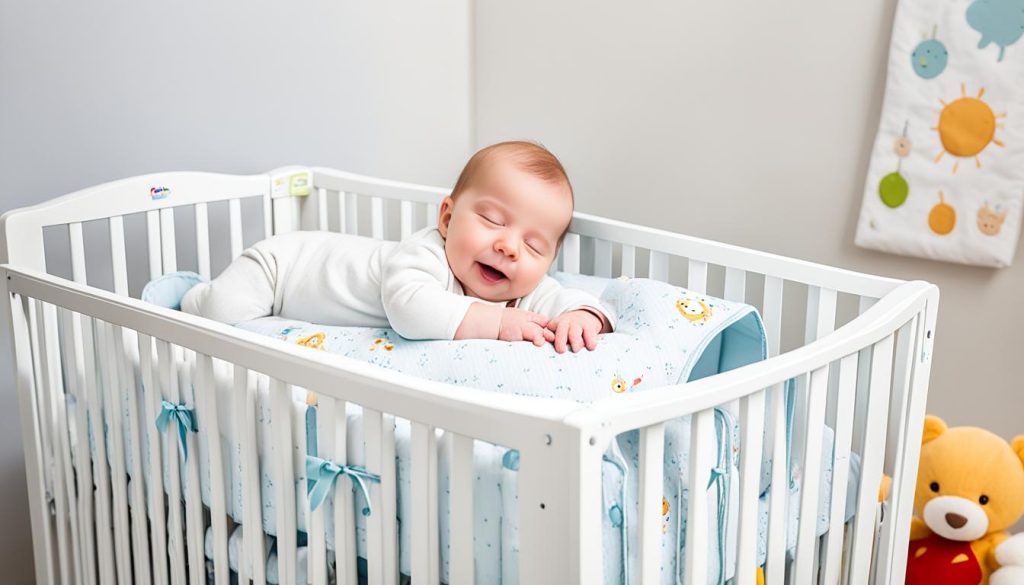
Key Safety Features
When picking a crib, remember these important features:
- Mattress height: At least three adjustable positions
- Corner post height: Over 16 inches to prevent strangulation
- Mattress fit: Snug, with no more than two fingers’ width between mattress and crib side
- Mattress thickness: No more than 6 inches
Cribs made after 2011 must follow the latest safety rules. Don’t use cribs that are over 10 years old, as they might not be safe.
Types of Cribs Available
Choosing the right crib is key for your baby’s safety and comfort. There are many crib types to fit different needs and likes.
Standard Size Cribs
Standard size cribs are the most common, making up 60-70% of the market. They offer plenty of space for your growing baby. Plus, they often have adjustable mattress heights.
Convertible Cribs
Convertible cribs are becoming more popular, with a 20-30% increase in recent years. These cribs grow with your child. They change from cribs to toddler beds and even full-size beds.
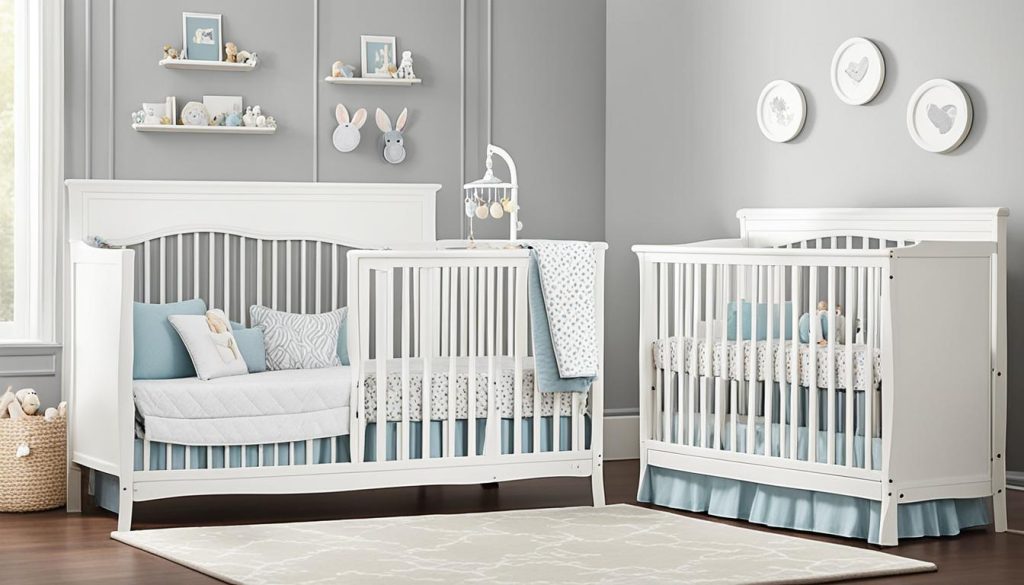
Mini Cribs
Mini cribs are great for small spaces, chosen by 15-20% of parents. They provide a compact solution without losing safety or comfort.
Portable Cribs
Portable cribs make up 10-15% of purchases. These folding cribs are perfect for families who travel a lot or need a space-saving option.
Multi-Functional Cribs
About 5-10% of parents choose multi-functional cribs. These cribs do it all, often with storage or changing tables, making the most of nursery space.
Round Cribs
Round cribs, at 3-5% of the market, offer a unique look. They can be a stylish addition to your nursery while also saving space.
When picking a crib, think about your space, budget, and future needs. All new cribs sold in the U.S. must meet safety standards set by the Consumer Product Safety Commission.
Choosing the Right Crib for Your Nursery
Choosing the right crib is key when getting ready for your baby. Think about your space, future needs, and budget. Standard cribs are stable, and convertible ones grow with your child.
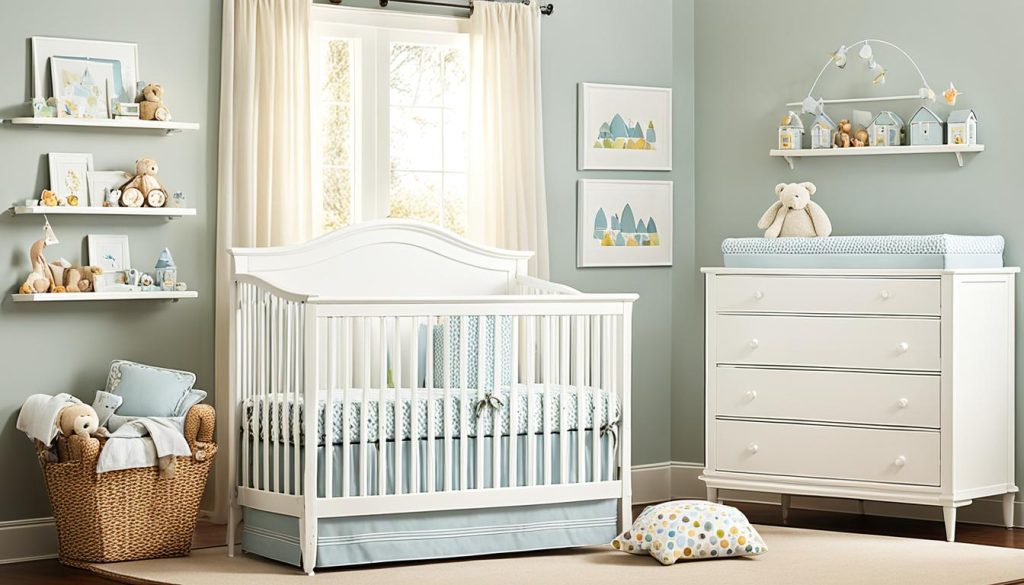
For small spaces, mini or portable cribs are great. Multi-functional cribs save space by offering storage and changing areas. Make sure the crib matches your nursery’s style for a unified look.
Safety is the top priority when picking a crib. Look for these important features:
- Slats spaced no more than 2 3/8 inches apart
- Firm mattress that fits snugly
- Sides at least 26 inches high in the lowest position
- No drop rails or protruding corner posts
Avoid crib bumpers, big toys, and extra support items. Keep the crib away from windows, radiators, and drafts for your baby’s safety and comfort.
Crib prices vary from $100 to $1000. Portable mesh cribs are affordable, while convertible ones are a good investment for the future. Pick a crib that meets your needs, budget, and ensures safety and comfort for your baby.
Crib Materials and Construction
Choosing the right crib is key for your baby’s safety and durability. Your baby will spend a lot of time in their crib. So, it’s important to pick one that’s safe and strong.
Wood vs. Metal Frames
Cribs can be made of wood or metal. Wooden cribs look classic and are strong. Hardwoods like birch or maple are great for lasting a long time.
Metal cribs offer a modern look and are often lighter. They can also be a good choice, depending on what you like and need.
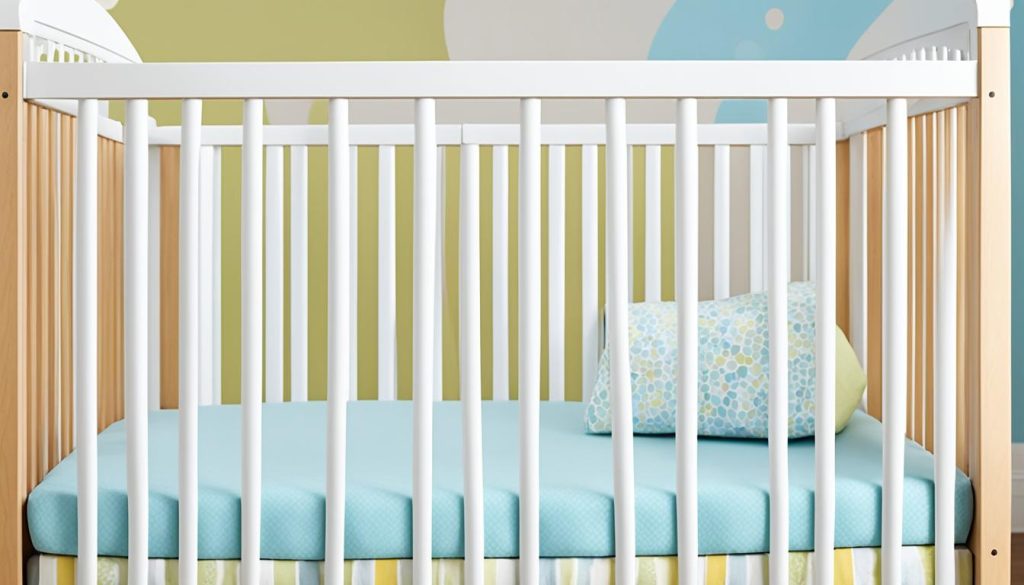
Non-Toxic Finishes
Non-toxic cribs are essential for your baby’s health. Make sure to choose cribs with finishes that are safe. GREENGUARD Gold certified cribs have low chemical emissions.
This means cleaner air for your baby to breathe while they sleep. It’s important for their health.
Sturdy Construction Techniques
The way a crib is built is key for safety and lasting a long time. Wooden cribs should have solid joints. Metal cribs should have strong welded joints.
Avoid cribs with decorative cutouts that could be dangerous. The slats should be no more than 2 3/8 inches apart to keep your baby safe.
- Choose hardwood for durability
- Look for non-toxic finishes
- Check for sturdy joints
- Ensure proper slat spacing
A well-built crib can last for years. It’s worth the time to find one that meets safety standards and fits your nursery style. Your baby’s comfort and safety are important.
Crib Mattress Considerations
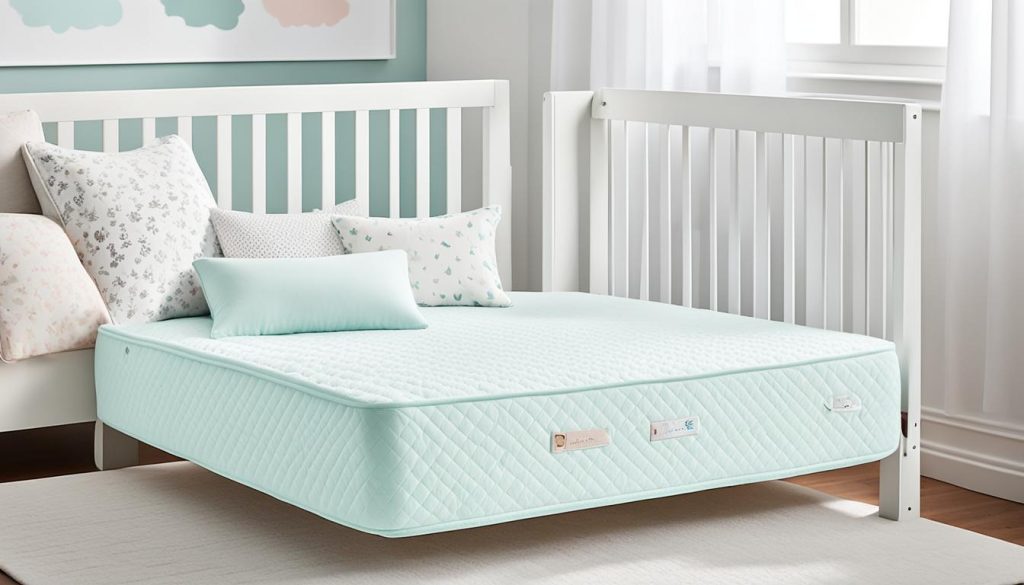
Choosing the right crib mattress is key for your baby’s safety and comfort. The Consumer Product Safety Improvement Act of 2008 has strict rules for crib mattress sizes. A full-size crib mattress must be at least 27 1/4 inches wide and 51 1/4 inches long. It should also be no thicker than 6 inches.
When looking for a crib mattress, keep these tips in mind:
- Ensure a snug fit with no more than a 1/2 inch gap when centered
- Choose a firm mattress that doesn’t sag under your baby’s weight
- Look for innerspring mattresses with a steel gauge of 15.5 or lower
- Opt for denser foam to prevent compression and promote safe infant sleep
It’s wise to buy a new crib mattress to avoid risks from used ones. New mattresses are less likely to have mold, bacteria, or harmful chemicals that could hurt your baby.
Think about organic options certified by GOTS or GOLS for peace of mind. These standards ensure the mattress is organic and made without harmful substances like phthalates and VOCs.
“A safe sleep environment starts with the right crib mattress. Don’t compromise on your baby’s comfort and health.”
Remember, different cribs need specific mattress sizes. Standard cribs use 28 x 52 inch mattresses, while mini cribs need 24 x 38 inch ones. Always check the measurements to make sure the mattress fits your crib perfectly.
Adjustable Mattress Positions: Why They Matter
When picking an adjustable crib for your baby, think about the benefits of adjustable mattress positions. This feature boosts crib safety and makes life easier for parents as your baby grows.

Safety Benefits
Adjustable mattress positions are key for your baby’s safety. They stop your child from climbing out and falling as they move more. Sadly, over 3,500 babies die each year from unexpected sleep incidents, often due to unsafe sleep settings.
Convenience for Parents
For newborns, a higher mattress is ideal for easy lifting in and out. As your baby gets bigger, you can lower the mattress for safety. Most cribs have 3-4 height settings, fitting your child’s growth stages.
Creating a safe sleep area is crucial to stop sleep-related deaths in infants. Adjustable crib mattress positions help achieve this goal and simplify parenting life.
“Adjustable mattress positions in cribs are a game-changer for both safety and convenience. They grow with your baby, providing peace of mind at every stage.”
Crib Styles and Nursery Decor
Choosing the right crib style can greatly impact your nursery decor. Crib designs vary from classic to modern, fitting every taste. Think about how the crib matches your nursery theme when you pick one.
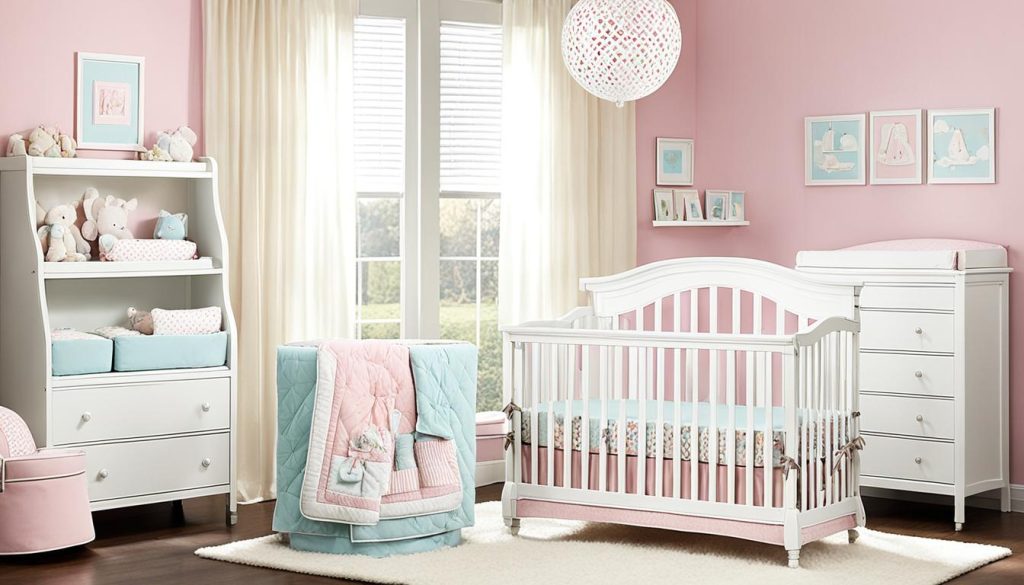
Traditional cribs, like the Jenny Lind style, have spindle slats. They bring a timeless beauty to your baby’s room. Modern cribs, on the other hand, have clean lines and a minimalist look, ideal for contemporary nurseries.
Some popular crib styles include:
- Sleigh cribs with curved headboards
- Convertible cribs that grow with your child
- Round cribs for a unique nursery centerpiece
- Mid-century modern cribs with tapered legs
When choosing a crib design, consider your nursery’s color scheme and theme. White cribs are versatile and match most decor. For a bold look, try a crib in a vibrant color or natural wood finish.
A well-chosen crib can be the focal point of your nursery, tying together all your decor elements.
Remember, crib styles should balance looks with safety. Choose designs that meet safety standards and fit your nursery decor. With careful selection, you’ll find a crib that’s both beautiful and functional for your baby’s space.
Budget-Friendly Crib Options
Finding the perfect crib for your baby doesn’t have to be expensive. Many affordable cribs are safe and stylish without being too pricey. Let’s look at some budget-friendly choices that help you create a cozy nursery without spending too much.
Affordable Brands
Several brands offer cribs that are easy on the wallet but still safe and valuable. These cribs cost between $139 and $280 on average. Here are some popular ones:
- Delta Children Essex 4-in-1 Convertible Crib ($200)
- Storkcraft Hillcrest 4-in-1 Convertible Crib ($200)
- IKEA Singular Crib ($179)
These cribs are made of solid wood and have adjustable mattress heights. They also convert, growing with your child from infancy to toddlerhood and beyond.
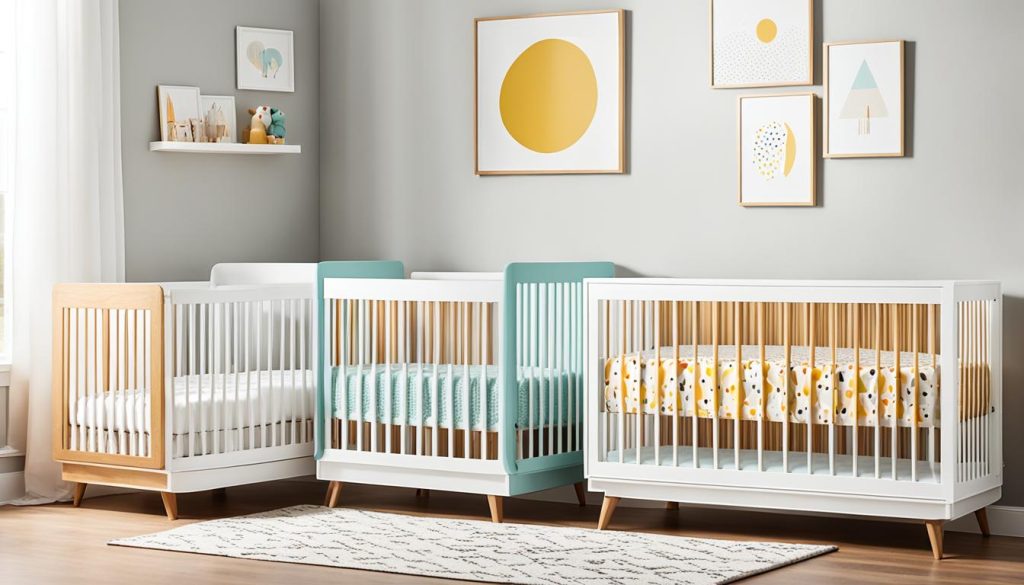
Second-Hand Cribs: Pros and Cons
Second-hand cribs might seem like a good deal, but they come with risks. It’s hard to know if they’re safe for your baby. The U.S. Consumer Product Safety Commission warns against using old cribs because they might not be safe.
If you’re thinking about a used crib, check it carefully for damage. Make sure it follows the latest safety rules, like proper slat spacing and strong construction. Your baby’s safety is the most important thing.
Safety tip: Always choose safety over cost when picking a crib for your baby.
Whether you choose a new or used crib, make sure it’s safe and comfy for your baby.
Setting Up Your Crib Safely
Setting up your baby’s crib right is key for safety. Let’s look at important steps for assembling and placing the crib. This will help make a safe place for your baby to sleep.
Proper Assembly Tips
Always follow the maker’s instructions when putting together the crib. Make sure all parts are tight and nothing is loose. The American Academy of Pediatrics says the mattress should be at least 27-1/4 inches by 51-1/4 inches. It should also be no thicker than 6 inches.

Crib Placement in the Nursery
Where you put the crib is very important for safety. Put it away from windows to keep out drafts and sunlight. Make sure it’s not near curtain cords or blind strings to stop strangulation. Keep it far from heaters or radiators for a good temperature.
- Place the crib in your bedroom for at least the first six months
- Keep the crib away from radiators and windows
- Avoid direct sunlight exposure in the morning or bright streetlights at night
Did you know sharing a room with your baby can cut the risk of SIDS by up to 50%? The American Academy of Pediatrics suggests having your baby’s crib in your room for at least six months.
“A safe sleep environment can significantly reduce the risk of SIDS and other sleep-related infant deaths.”
Keep the crib empty for the first year, using only a fitted crib sheet. With these tips, you’re making a safe sleep space for your baby.
Crib Accessories: What’s Safe and What’s Not
Creating a safe sleep area for your baby is key. Many crib accessories might look cute but can be dangerous. Let’s look at what’s safe and what’s not for your baby’s crib.
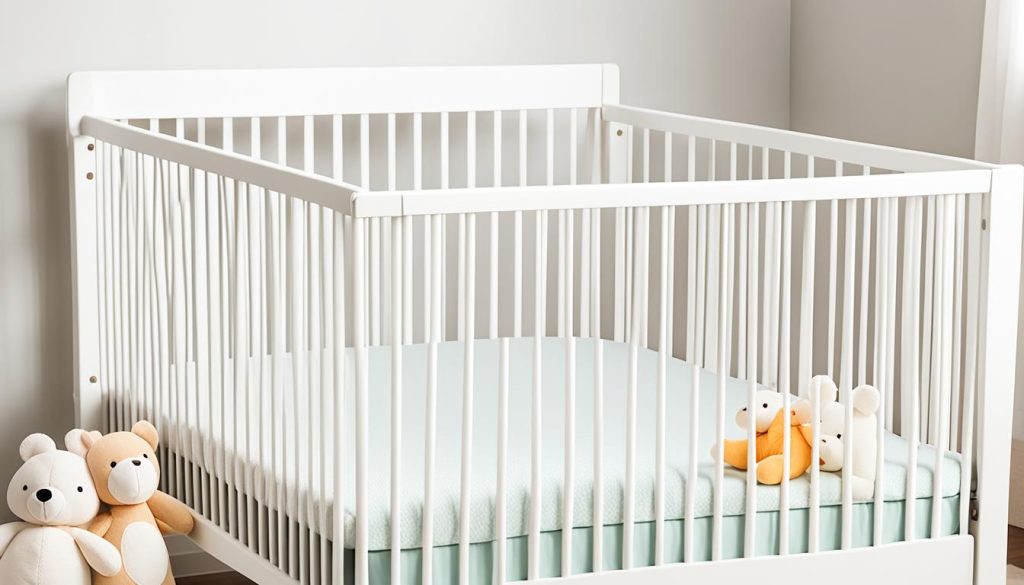
Safe sleep habits are very important. The American Academy of Pediatrics suggests a bare crib for safety. This means no pillows, blankets, or stuffed animals. These items can raise the risk of suffocation and Sudden Infant Death Syndrome (SIDS).
So, what can you use? A fitted sheet made for your crib mattress is a must. It should fit tightly without any loose fabric. For keeping your baby warm, think about a wearable blanket or sleep sack instead of loose blankets.
- Avoid: Crib bumpers, pillows, loose blankets, stuffed animals
- Use: Fitted sheet, wearable blankets
Crib accessories like mobiles can be used but with care. Make sure they’re securely attached and out of your baby’s reach. Remove them once your little one can sit up.
Remember, a clean crib is a safe crib. Keep toys and other items away from the sleeping area. These can become climbing hazards as your baby grows. By following these tips, you’ll make a secure and peaceful sleep space for your little one.
Transitioning from Crib to Toddler Bed
Moving your child from a crib to a toddler bed is a big step. The best time to switch depends on your child. Look for signs that show they’re ready.
When to Make the Switch
Typically, toddlers are ready for a toddler bed between 18 and 24 months. Signs include:
- Climbing out of the crib
- Height over 35 inches
- Showing interest in a “big kid” bed
- Bringing toys into the crib
Don’t worry if your child is happy in the crib and not climbing out. It’s fine to wait.
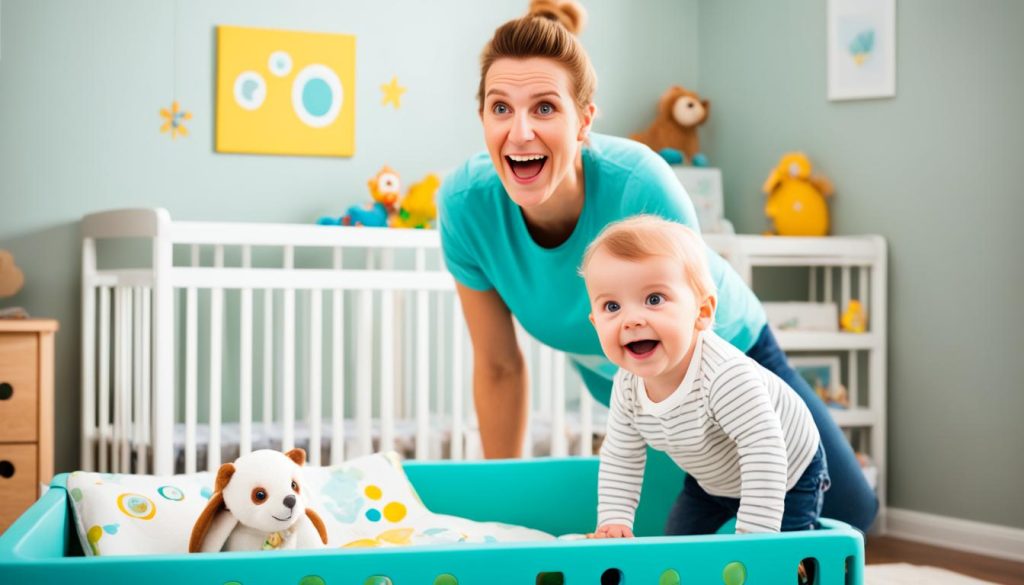
Choosing a Convertible Crib
A convertible crib makes the switch easier. These cribs turn into toddler beds, saving money and space. Look for these things:
- Sturdy construction
- Safety certification
- Included conversion kit
- Style that grows with your child
Child Craft offers safe, quality convertible cribs that last a long time.
Place the new bed where the crib was. Add familiar items like favorite blankets or stuffed animals. Use nightlights for safety, and consider a toddler clock to help your child know when it’s time to get up.
“Patience and practice are key in the crib to bed transition. Make it an exciting adventure for your child, and don’t rush the process.”
This change may take time. Support your child with reassurance and encouragement. Soon, they’ll be sleeping well in their new big kid bed!
Maintaining Your Crib for Longevity
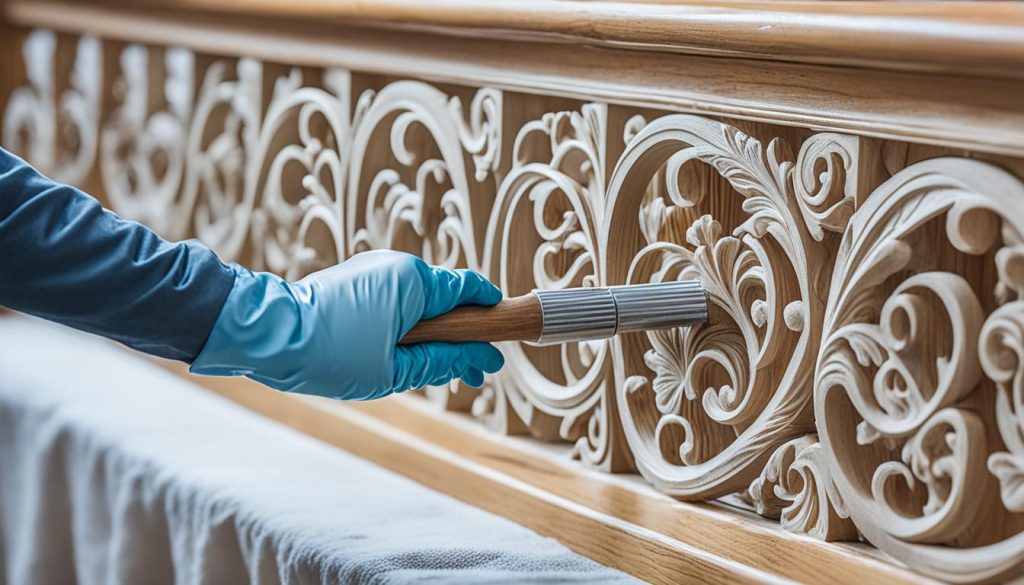
Keeping your crib in good shape is crucial for its longevity. Regular care not only makes it last longer but also keeps your baby safe. Here are some easy tips for taking care of your nursery furniture, ensuring your crib lasts for years.
First, check your crib’s stability often. Make sure all bolts and screws are tight for safety. Cleaning your crib with mild soap and water, as the maker suggests, is also important.
Look for any damage on your crib regularly:
- Peeling paint
- Splinters
- Damaged parts
If you find any damage, fix it right away. Replace any broken parts quickly. Always have the original instructions ready for how to use and care for your crib.
Did you know? Some cribs come with great warranties. For example, Kaplan’s Safe & Sound Fixed Side Clearview Compact Crib has a five-year warranty for the whole crib and a lifetime warranty on the frame, casters, and hardware.
“A well-maintained crib is a safe crib. Regular checks and care can significantly extend your crib’s life, ensuring it remains a secure sleep space for your little one.”
Remember, it’s not just about making your crib last longer. It’s also about keeping your baby safe and comfortable. By following these easy steps, you’re doing a lot for your child’s safety and your own peace of mind.
Closing Thoughts
Starting your journey in newborn care means choosing the right crib is key. You’ll find many options, from standard to mini cribs. It’s important to focus on safety and think about what you need.
A firm mattress and a bare crib are essential for keeping your baby safe. They help lower the risk of SIDS.
When looking for a crib, remember safety standards have changed a lot since 2011. Search for cribs with Greenguard Gold Certification and CARB II compliance. These certifications mean the crib has low VOC emissions, giving you peace of mind.
Even though ‘non-toxic’ isn’t officially regulated, these certifications are a good sign. They show the crib is safe for your baby.
Your budget will affect your choices, but safety should always come first. You might choose a convertible crib or a portable one for travel. Just make sure it meets the latest CPSC and ASTM standards.
By being informed and making smart choices, you’ll make a safe, cozy space for your baby. This way, your little one can grow and thrive in a secure environment.

